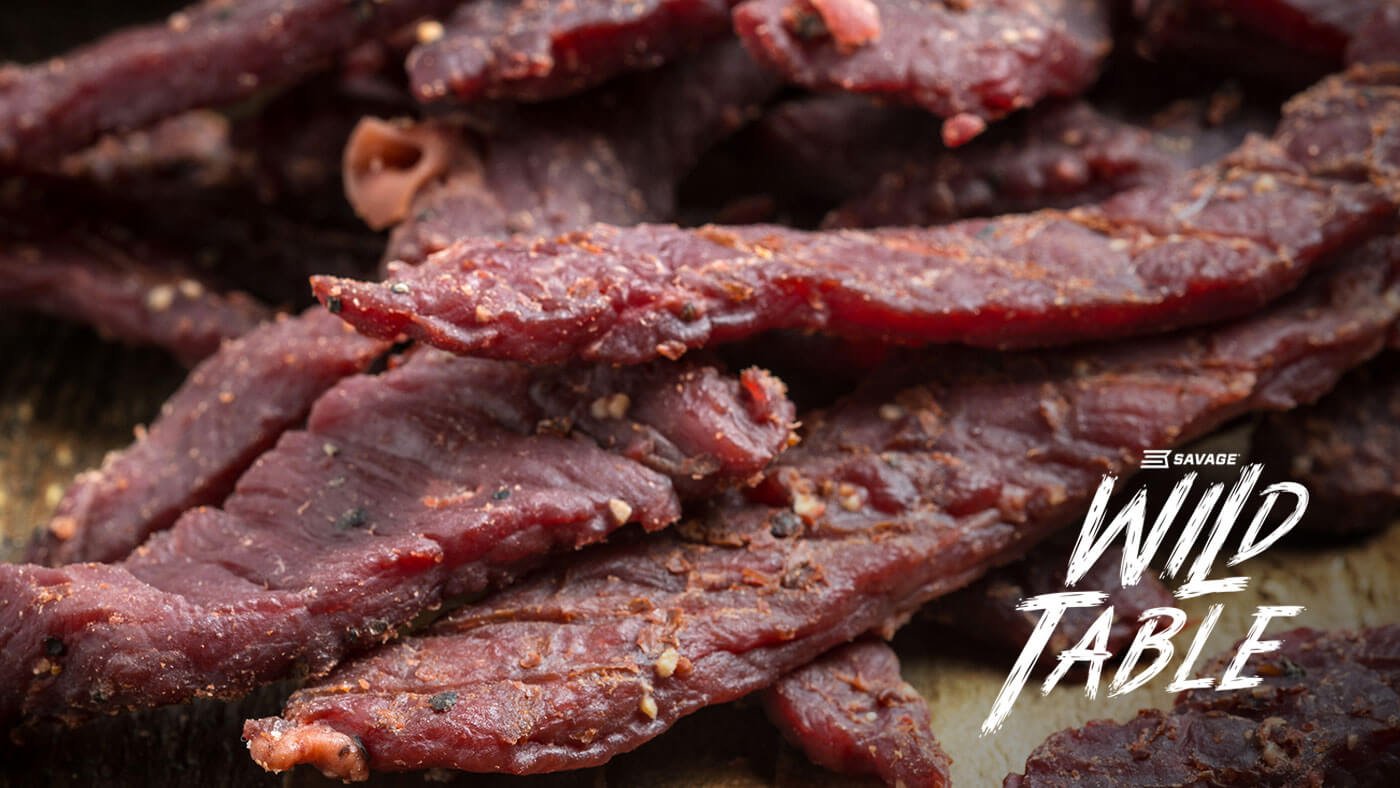- Savage Blog
- How to Make Deer Jerky from Whole Muscle Meat
How to Make Deer Jerky from Whole Muscle Meat

Although many types of meat can be used to make jerky like beef, turkey, goose, and duck, one of our favorites is venison or deer jerky. You can make deer jerky from ground meat, but we recommend making your first batch out of sliced whole muscle (round or flank steaks— beef or wild game is preferred).
We’ll outline several different cooking methods and the equipment you need for each. Remember that your meat must reach an internal temperature of 165° F (74° C) to be safe for consumption.
Our Favorite Equipment
- Coolers
- MEAT! Grinder
- MEAT! Slicer
- MEAT! Dehydrator
- MEAT! Scales
- MEAT! Jerky Gun Kit
- MEAT! Slicer
- HiMTN Seasonings Jerky Kits
- HiMTN Garlic and Pepper Mix
- HiMTN Jerky Board
- Outdoor Edge Knives ERGOMax Processing Kit
How to Prepare Meat to Make Deer Jerky
- Slice the whole muscle 1/4” (5mm) thick, with the grain. Slicing is made easy with the Hi Mountain Jerky Board and Outdoor Edge Knives, or a MEAT! Slicer.
- Cut the meat into strips of desired lengths and widths, always allowing for shrinkage. Weigh the meat AFTER cutting into strips. Now you know the exact amount of mix to use.
- Mix the spices and cure according to the mixing chart below. Mix only the amount you need. Be sure to store the remaining unmixed spices and cure in an air-tight container until needed.
- Note: We use pure spices, leaving the natural oils intact which can cause caking. Simply put in your food processor or coffee grinder to break up.
- Lay the strips flat on an even surface. Pat dry.
- Apply the mixed spices and cure to the prepared meat using the enclosed handy sprinkler bottle.
- Sprinkle the first side of meat with approximately 1/2 of the mixture. Turn the meat over and sprinkle the remaining mixture on the meat. Next, put seasoned strips in a large mixing bowl and tumble by hand until the mixture has been spread evenly on all sides of the meat.
- Store the strips in a plastic storage bag or NON-METALLIC container and refrigerate for at least 24 hours. (Storing the strips in a metal bowl can leave your meat with a metallic taste) Hi Mountain Jerky Cure and Seasoning is specially formulated to penetrate meat at the rate of 1/4” (5mm) per 24 hours. If thicker pieces of meat are used, increase curing time accordingly—for instance, cure 3/8” (8mm) strips approximately 28 hours.
How to Smoke or Cook Deer Jerky
USING AN OVEN: Place foil or pan on the bottom of the oven to catch drippings. Lay the strips on the oven racks, making sure there is air between each piece (our Jerky Screens are perfect here, we suggest spraying with nonstick cooking spray). Place in oven for 1 to 1 1/4 hours at 200 degrees F (93° C) with the oven door open just a crack. Taste the jerky frequently. When the jerky is cooked to your liking, stop cooking. Deer jerky does not have to be so dry you can’t chew it like commercially made jerky. Remember, taste often while cooking or smoking.
USING A SMOKEHOUSE/SMOKER: All smokers are different. The location, temperature, wind, and heat source can affect the smoker. This is where you need to experiment. We recommend smoking the deer jerky at 200° F (93° C) for 1 1/2 to 2 hours with smoke on; if your smoker will not reach 200° F (93° C), leave the meat in longer, but do not leave smoke on for more than 3 hours until you have tasted it.
DO NOT OVER COOK—DO NOT OVER SMOKE!
USING A DEHYDRATOR: Follow your dehydrator instructions, remember meat must reach an internal temperature of 165° F (74° C) to be safe.
Mixing Chart for Whole Muscle Meat
Jerky Kits will cure and season 15 pounds of whole muscle meat
Always use standard measuring spoons. Level seasoning and cure with a knife.
Measure the spices and cure accurately.
- 1 lb. (450gm) of whole muscle meat: use 1 1/2 teaspoons of seasoning and 2 teaspoons of cure
- 2 lbs. (900gm) of whole muscle meat: use 1 tablespoon of seasoning and 1 tablespoon plus 1 teaspoon of cure
- 3 lbs. (1.360gm) of whole muscle meat: use 1 tablespoons plus 1 1/2 teaspoons of seasoning and 2 tablespoons of cure 4 lbs. (1.800gm) of whole muscle meat: use 2 tablespoons of seasoning and 2 tablespoons plus 2 teaspoons of cure
Making Jerky with GROUND MEAT
This cure and seasoning is excellent for use with extra lean ground meat. Make 1 to 3 lbs. at a time. We suggest you start with a small batch at first. When making jerky with ground meat, Hi Mountain’s Jerky Master is an excellent tool, while the jerky screen is a must. You can add in flavors such as garlic, pepper, onion, jalapeño, or any other powdered spice to our seasoning to personalize your deer jerky!
- Mix cure and seasoning according to the chart below.
- Add up to 1/4 cup ice water per each pound of meat. Mix meat, water, and seasoning thoroughly for approximately 5 minutes, or until sticky (reduces shrinkage).
- After mixing, wrap in plastic and refrigerate for at least 4 hours or overnight.
- After removing it from the refrigerator, lay the seasoned meat between 2 large sheets of wax paper. Roll meat with a rolling pin into a large rectangular patty approx. 1/4" thick.
- Cut into strips 1” (2.5cm) wide or wider with a wet table knife. Remove from wax paper and place on the Jerky Screen, then in the oven (smoker or dehydrator) on top rack at 200° F (93° C) for 1 hr. 20 min. or more if you like a dryer product.
Mixing Chart for GROUND MEAT JERKY
Jerky Kits will cure and season up to 10 pounds of ground meat
Always use standard measuring spoons. Level seasoning and cure with a knife.
More seasoning is required for ground than for whole muscle meats.
Remember, for best results, measure the spices and cure accurately.
- 1 lb. (450gm) of ground meat: use 2 1/2 teaspoons of seasoning and 2 teaspoons of cure
- 2lbs.(900gm) of ground meat: use1tablespoonplus2teaspoonsofseasoningand1tablespoonplus1teaspoonofcure 3lbs.(1.360gm) of ground meat: use2tablespoonsplus11/2teaspoonsofseasoningand2tablespoonsofcure
- 4 lbs. (1.800gm) of ground meat: use 3 tablespoons plus 1 teaspoon of seasoning and 2 tablespoons plus 2 teaspoons of cure
Recipe Adapted from CRUSH Camp Outdoor Chef, Jason Ellsworth @ellsworth.cooks
Are you a field to table foodie? Check out more of our wild game recipes and foraging tips on our Wild Table blog!


